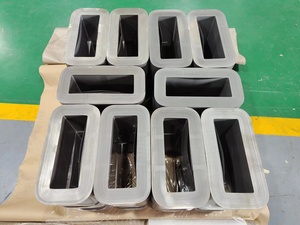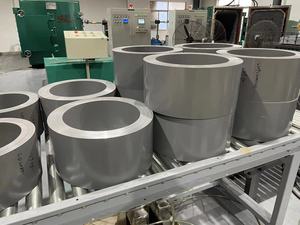
All categories
Featured selections
Trade Assurance
Buyer Central
Help Center
Get the app
Become a supplier

(69143 products available)













The high-power transformer core comes in different nature to serve varying functions. Each type has unique features and benefits related to the performability of the transformer at high power and frequency.
Silicon steel is mainly used in high-power transformers because of its reduced operational costs. The silicon content increases the electrical resistivity of iron, which decreases the eddy currents and energy losses during iron operation. The steel is processed to allow it to operate and function at the optimum levels even under high magnetic fields. The laminated silicon steel reduces energy loss due to heat generation, which is named core loss or iron loss.
Amorphous steel, or supercooled steel, is a comparatively new core material used in transformers. The material is non-crystalline and gives low core losses than laminated silicon steel due to its high electrical resistivity. The amorphous core is manufactured in a very thin and ribbon-like structure that boosts their efficiency and reduces energy losses due to heat, mainly in non-load and low-energy-consuming transformer applications.
Ferrite cores are ceramic magnetic materials, often soft magnets. They are mainly used in small transformers, inductors, and high-frequency applications. They are not as potent as silicon steel cores in high-power applications. However, ferrite cores can effectively reduce electromagnetic interference (EMI) in high-frequency power supplies. They are lighter, highly resistive to eddy currents, and ideal for compact designs.
Laminated steel cores are often used while building large power transformers. The design of the lamination helps in the reduction of eddy current losses. The thin laminations of steel are insulated from each other using a thin layer of non-conductive material, which means that the eddy currents are lowered. The typical lamination grain structure helps in the easy magnetization of the core and reduces core losses as much as possible.
Toroidal cores are ring-shaped magnetic cores that can be easily made from various materials, including ferrite and silicon steel. These cores are commonly used in compact transformers and inductors. The circular shape provides a continuous magnetic path, reducing the leakage flux and improving efficiency. Toroidal cores are popular in applications where space is limited, such as in audio equipment and power supplies.
The high-power transformer core supports the windings' roles, which helps the efficient transfer of electrical energy from one circuit to another through electromagnetic induction. The core is designed to enhance the magnetic flux created by the alternating current (AC) in the primary winding, thus improving the transformation's efficiency. In high-power applications, reducing energy losses, especially core losses (hysteresis and eddy currents), is crucial for maintaining the transformer's reliability and performance.
The following aspects define most of the transformer core types:
The design of high-power transformer cores focuses on balancing efficiency, size, and cost. Core materials are selected based on their magnetic properties and ability to withstand high power without excessive heating. Laminated cores are commonly used to reduce eddy currents, while amorphous cores offer lower core losses for specific applications. Advanced core designs also consider factors like noise reduction and ease of maintenance in industrial settings.
The high-voltage power distribution grids extensively use high-power transformer cores. In their case, transformers commonly step up or step down the voltages for effective electrical energy transmission over long distances. The transformer core materials are usually designed to efficiently handle the large magnetic fluxes involved in these operations. Other than the efficiency losses at the core, they also minimize core losses to ensure practical reliability over many years of continuous use.
These plants have heavy machinery and equipment that operate at high voltage and current levels, such as electric motor drives, induction furnaces, and large welding machines. The role of transformers here is to change the electrical power to the right voltage levels that the large equipment requires. High-power transformer cores used here should be very efficient and strong.
Solar power plants use inverters, and wind farms use transformers with high-power core materials. The role of these transformers is to step up the voltage of the generated electrical power to grid levels. Wind and solar energies are power sources that require efficient energy use and loss minimization. This is why transformer cores are important in these renewable facilities.
Oil and gas facilities like pipeline pumping stations and compressor stations make transformers with high-power cores to ensure the movement of fluids through pipelines and the production of electricity. Large circuits in oil and gas transportation and facilities require high-efficiency transformers to reduce the costs involved in energy losses.
Traction substations on railways convert high-voltage AC from the grid into lower-voltage DC and AC for trains. These substations employ transformers with silicon steel or other high-efficiency core materials. The loss is reduced to ensure that the system is practical and can serve for a long time without needing too much maintenance.
A. The transformer core material most often used for high-power transformers is laminated silicon steel due to its magnetic properties and reduced eddy current losses. Amorphous steel is also increasingly used for its lower core losses.
A. Core losses consist of hysteresis and eddy current losses. They are important because they represent the energy dissipated as heat within the transformer during operation. Minimizing core losses improves the efficiency and reliability of the transformer, reducing energy wastage.
A. The core material affects the transformer's efficiency due to the level of core losses and how well it can support the magnetic field. Materials with higher magnetic permeability and lower eddy currents, such as laminated silicon steel, improve efficiency by reducing energy losses.
A. Lamination of the core material reduces the eddy currents and associated energy losses. Each lamination is thin and insulated from the others, which restricts eddy currents while still allowing the magnetic field to pass through effectively.
A. Ferrite cores are suitable for high-frequency applications. They have low eddy current losses and are light, making them ideal for switching power supplies and other high-frequency transformers.